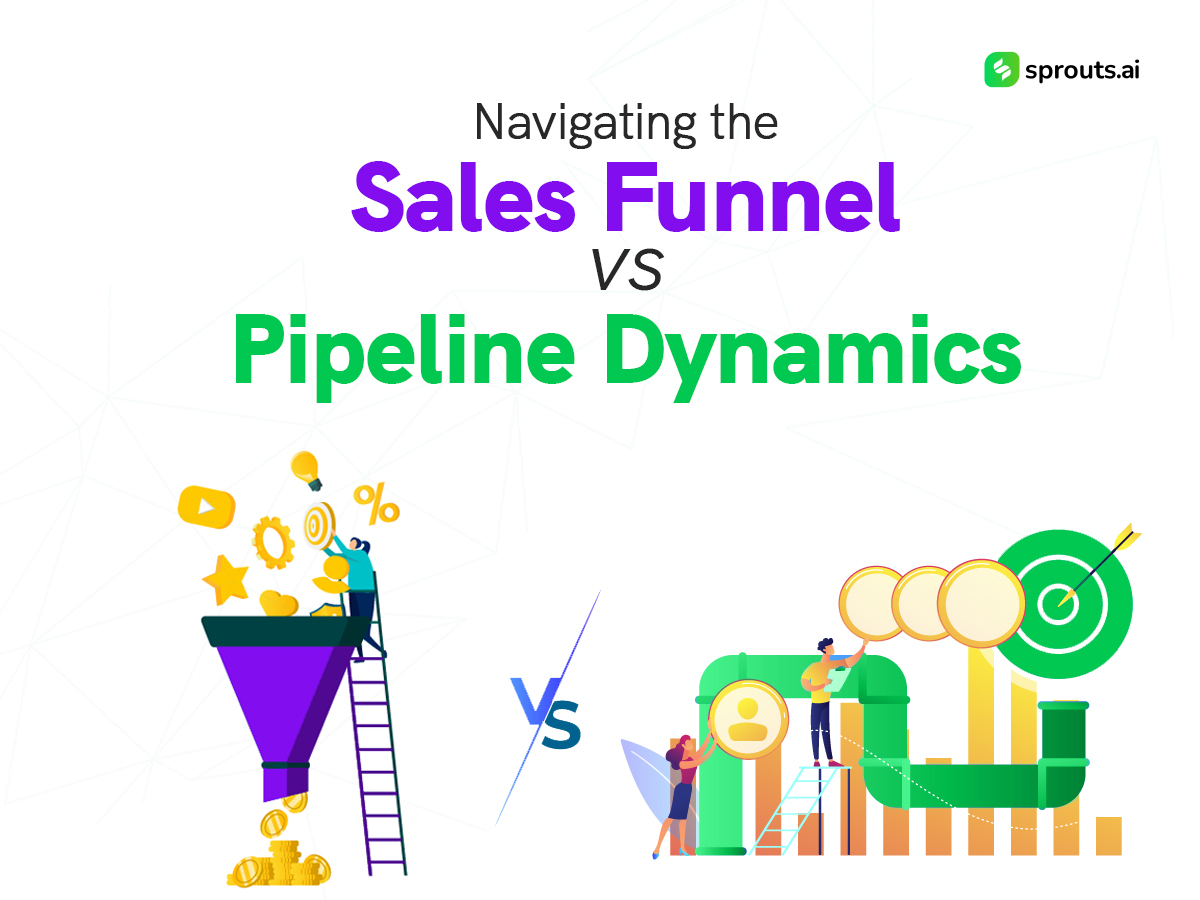The journey from prospect to customer is a dynamic process. This process often called the sales journey, is guided by two key concepts: the sales funnel and the sales pipeline. These terms are frequently used interchangeably but possess distinct characteristics that play crucial roles in a company’s sales strategy. In this blog, we’ll discuss the difference between sales pipeline and sales funnel, understand their unique attributes, and explore how they synergize to drive sales success.
1. Understanding the Sales Funnel: Crafting the Customer Journey
Imagine a funnel—a wide opening at the top that narrows down as it progresses downward. The sales funnel follows a similar pattern, depicting a potential customer’s stages before making a purchase decision.
Awareness: The wide top of the funnel represents the awareness stage, where potential customers are introduced to a product or service. This is where marketing efforts shine, creating brand visibility and piquing interest through various channels like social media, advertising, and content marketing.
Interest and Consideration: As prospects move down the funnel, their interest deepens. Here, they seek more information, compare options, and evaluate how a product or service can address their needs. To nurture this interest, marketers, and sales teams must provide compelling content, case studies, and personalized interactions.
Intent and Evaluation: At this stage, the funnel further narrows as potential customers actively intend to purchase. They dive deeper into product specifications, pricing, and reviews. This is a critical juncture where sales professionals play a vital role by addressing doubts and guiding prospects toward a favorable decision.
Purchase: The funnel’s neck finally leads to the purchase stage. The prospect becomes a customer, and the transaction takes place. Effective customer service during this phase enhances the overall experience and lays the groundwork for potential repeat business and referrals.
Post-Purchase Relationship: The funnel’s journey doesn’t end with the purchase. Delighting the customer after the sale fosters loyalty, encouraging them to become brand advocates. This can lead to valuable word-of-mouth marketing and the possibility of upselling or cross-selling in the future.
2. The Sales Pipeline: Nurturing Prospects to Closure
Unlike the sales funnel, the sales pipeline focuses on the activities and steps the sales team takes to convert prospects into customers. It’s a visual representation of a deal’s various stages, from initial contact to closure.
Prospecting: This is where potential leads are identified and gathered. It involves research, networking, and lead-generation efforts. A well-defined target audience helps streamline this phase.
Initial Contact: Here, the sales team makes the first connection with the prospect. This could be through cold calling, emails, or social media outreach. Building rapport and understanding the prospect’s needs is crucial.
Qualification: In this stage, leads are evaluated to determine their potential as customers. Does the prospect have the budget, authority, need, and timeline (BANT) to purchase? Qualifying leads prevents wasting time on those unlikely to convert.
Proposal and Presentation: This is where solutions are tailored to the prospect’s needs. A compelling proposal, backed by data and testimonials, can significantly influence decision-making.
Negotiation: Negotiating terms, pricing, and addressing concerns often come next. Effective communication and flexibility are key during this phase.
Closing: The pipeline culminates in the closing stage when the deal is sealed. Successful closure depends on alignment between the solution offered and the prospect’s needs.
3. Creating The Harmony: How Funnel and Pipeline Align
Understanding the sales funnel and pipeline independently is important, but recognizing their interplay is equally vital. The funnel’s stages mirror the buyer’s journey, while the pipeline showcases the seller’s actions to guide that journey. When aligned seamlessly, these concepts create a comprehensive sales strategy.
Personalization: The funnel emphasizes understanding the buyer’s journey and tailoring interactions accordingly. The pipeline echoes this by ensuring each interaction is personalized and relevant to the prospect’s position in the pipeline.
Data-Driven Decisions: The funnel’s stages are driven by customer behavior and preferences data. The pipeline relies on data to assess which prospects are likely to convert and what strategies are effective at each stage.
Collaboration: The funnel emphasizes collaboration between marketing and sales teams to provide consistent messaging. The pipeline reinforces this collaboration, as both teams need to align their efforts for a smooth progression of leads.
Continuous Improvement: Just as the funnel involves constantly optimizing marketing strategies, the pipeline demands constant refinement of sales processes based on insights from each deal’s progression.
After learning about sales pipeline vs sales funnel, we saw how the sales funnel and pipeline are two essential tools that, when employed thoughtfully, lead to remarkable success. The sales funnel crafts a compelling narrative of the buyer’s journey, while the sales pipeline focuses on guiding prospects through the stages of closure. Recognizing the symbiotic relationship between these concepts is key to unlocking the full potential of a sales strategy. The interplay between the sales pipeline vs. sales funnel is not just harmonious but essential. Their alignment creates a comprehensive strategy that resonates with both buyers and sellers.

